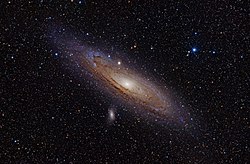Caldwell 17 (50290241446)
Caldwell 17, also known as NGC 147, is a dwarf galaxy located roughly 2.5 million light-years from Earth. It is a member of the Local Group of galaxies, which is dominated by our Milky Way and the Andromeda galaxy. Caldwell 17, like its neighbor Caldwell 18, is a distant satellite of the Andromeda galaxy. Just as the planets in the solar system are gravitationally bound to the Sun, so are these smaller galaxies bound to their much more massive galactic host. While many classes of galaxies can exist as satellites, dwarf spheroidal galaxies (small, dim, spherical-shaped galaxies) like Caldwell 17 have been observed in this role more frequently than any other type of galaxy.
Dwarf satellite galaxies tend to appear very diffuse and dim, so they can be difficult to spot (especially in light-polluted or hazy skies). Caldwell 17 is no exception. It has an apparent magnitude of 9.5, and observers will need a small telescope set up in a dark location to detect the faint galaxy. Caldwell 17 is located in the southern edge of the constellation Cassiopeia, between the constellation’s “W” pattern and the Andromeda galaxy. (The neighboring Caldwell 18 is brighter and less diffuse, so it is easier to see.) The best time of year to spot Caldwell 17 from the Northern Hemisphere is the autumn. It can also be seen in northern latitudes of the Southern Hemisphere in the spring. The galaxy was discovered by the English astronomer John Herschel in September of 1829.
This image of Caldwell 17 is a composite of observations made in visible and infrared light by Hubble’s Wide Field Camera 3. The image captures an area near the core of the galaxy, which is notable for its elderly stellar population. Astronomers used Hubble’s observations to investigate the properties of Caldwell 17’s many globular star clusters.
Credit: NASA, ESA, and A. Ferguson (University of Edinburgh, Institute for Astronomy); Processing: Gladys Kober (NASA/Catholic University of America)
For Hubble's Caldwell catalog website and information on how to find these objects in the night sky, visit: <a href="https://www.nasa.gov/content/goddard/hubble-s-caldwell-catalog" rel="noreferrer nofollow">www.nasa.gov/content/goddard/hubble-s-caldwell-catalog</a>Relevante Bilder
Relevante Artikel
NGC 147NGC 147 ist eine elliptische Zwerggalaxie vom Hubble-Typ dE5 im Sternbild Kassiopeia am Nordsternhimmel. Die Galaxie ist schätzungsweise 300.000 Lichtjahre von Andromeda entfernt und hat eine Größe von etwa 8000 Lichtjahren entlang der größten Abmessung. Sie ist eine Begleitgalaxie der Andromeda-Galaxie und bildet zusammen mit NGC 185 gravitativ gebundenes Galaxienpaar. .. weiterlesen



